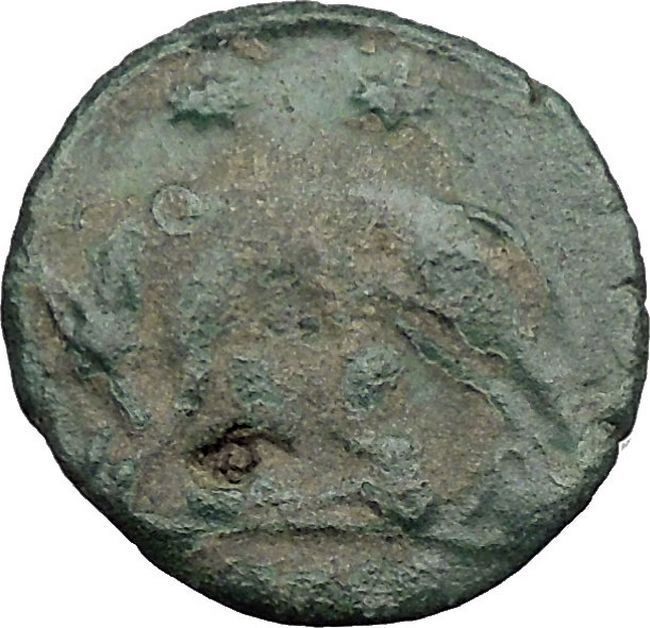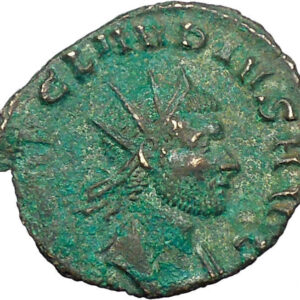|
Hadrian
–
Roman Emperor
: 117-138 A.D. –
Hadrian Travels to Egypt
Bronze As 24mm (10.38 grams) Rome mint, circa 134-138 A.D.
Reference: RIC II 839 var. (bust)
HADRIANVS AVG COS III P P, Bare head right.
AEGYPTOS,
Egypt
reclining left, holding sistrum and
resting elbow on basket of grain; at feet, ibis standing right on column
* Numismatic Note: This coin commemorated the travels that
Hadrian made to Egypt touring the provinces of the Roman empire.
You are bidding on the exact item pictured,
provided with a Certificate of Authenticity and Lifetime Guarantee of
Authenticity.

The
ibises (collective
plural ibis; classical plurals ibides and ibes) are a group
of long-legged wading birds
in the family
Threskiornithidae
.
They all have long, down-curved bills, and usually feed as a group, probing
mud for food items, usually
crustaceans
. Most species nest in trees, often
with spoonbills
or
herons
.
The word ibis comes from
Latin
ibis from
Greek
ἶβις ibis from
Egyptian
hb, hīb.

A
sistrum (plural:
sistrums or Latin sistra) is a
musical instrument
of the
percussion
family, chiefly associated with
ancient Egypt
. It consists of a handle and a U-shaped
metal frame, made of brass or bronze and between 76 and 30 cm in width. When
shaken the small rings or loops of thin metal on its movable crossbars produce a
sound that can be from a soft clank to a loud jangling. The name derives from
the Greek
verb σείω, seio, to shake, and
σεῖστρον, seistron, “that which is being shaken.” Its name in the ancient
Egyptian language
was sekhem (sḫm) and
sesheshet (sššt). Sekhem is the simpler, hoop-like sistrum, while
sesheshet (an
onomatopoeic
word) is the
naos
-shaped one.
Publius Aelius Hadrianus
(as emperor Imperator Caesar Divi Traiani filius Traianus Hadrianus Augustus,
and Divus Hadrianus after his
apotheosis
,
known as Hadrian in
English
; 24 January 76 – 10 July 138) was
emperor
of
Rome
from AD 117 to 138, as well as a
Stoic
and
Epicurean
philosopher. A member of the
gens
Aelia
,
Hadrian was the third of the so-called
Five Good Emperors
.
Hadrian was born Publius Aelius Hadrianus in
Italica
or, less probably, in Rome
,
from a well-established family which had originated in
Picenum
in
Italy
and had
subsequently settled in
Italica
,
Hispania Baetica
(the republican
Hispania
Ulterior), near the present day location of Seville, Spain. His predecessor
Trajan
was a
maternal cousin of Hadrian’s father.
Trajan never officially designated a successor, but, according to his wife,
Pompeia Plotina
, Trajan named Hadrian emperor immediately before his death.
Trajan’s wife was well-disposed toward Hadrian: Hadrian may well have owed his
succession to her.
Hadrian’s presumed indebtedness to Plotina was widely regarded as the reason
for Hadrian’s succession. However, there is evidence that he accomplished his
succession on his own governing and leadership merits while Trajan was still
alive. For example, between the years AD 100–108 Trajan gave several public
examples of his personal favour towards Hadrian, such as betrothing him to his
grandniece,
Vibia
Sabina
, designating him quaestor Imperatoris, comes Augusti,
giving him Nerva’s diamond “as hope of succession”, proposing him for consul
suffectus, and other gifts and distinctions. The young Hadrian was Trajan’s
only direct male family/marriage/bloodline. The support of Plotina and of
L. Licinius Sura
(died in AD 108) were nonetheless extremely important for
Hadrian, already in this early epoch.
Early
life
Although it was an accepted part of Hadrian’s personal history that Hadrian
was born in Italica
located in the province called
Hispania Baetica
(the southernmost Roman province in the
Iberian Peninsula
, comprising modern
Spain
and
Portugal
),
his biography in
Augustan History
states that he was born in Rome on 24 January 76 of a
family originally Italian,
but Hispanian for many generations. However, this may be a ruse to make Hadrian
look like a person from Rome instead of a person hailing from the provinces.
His father was the Hispano-Roman
Publius Aelius Hadrianus Afer
, who as a
senator
of praetorian
rank would spend much of his time in Rome.
Hadrian’s forefathers came from Hadria, modern
Atri
,
an ancient town of Picenum in Italy, but the family had settled in
Italica
in
Hispania Baetica soon after its founding by
Scipio Africanus
. Afer was a paternal cousin of the future Emperor
Trajan
. His
mother was Domitia
Paulina
who
came from Gades (Cádiz).
Paulina was a daughter of a distinguished Hispano-Roman Senatorial family.
Hadrian’s elder sister and only sibling was Aelia Domitia
Paulina
,
married with the triple consul
Lucius Julius Ursus Servianus
, his niece was Julia Serviana
Paulina
and
his great-nephew was Gnaeus Pedanius Fuscus Salinator, from
Barcino
. His
parents died in 86 when Hadrian was ten, and the boy then became a ward of both
Trajan and
Publius Acilius Attianus
(who was later Trajan’s Praetorian Prefect).
Hadrian was schooled in various subjects particular to young
aristocrats
of the day, and was so fond of learning
Greek
literature that he was nicknamed Graeculus (“Greekling”).
Hadrian visited
Italica
when
(or never left it until) he was 14, when he was recalled by Trajan who
thereafter looked after his development. He never returned to Italica although
it was later made a
colonia
in his honour.
His first military service was as a
tribune
of
the
Adiutrix Legio II
. Later, he was to be transferred to the
Minervia Legio I
in
Germany
. When
Nerva
died in 98,
Hadrian rushed to inform Trajan personally. He later became
legate
of a
legion
in Upper Pannonia
and eventually governor of said province. He was also
archon
in
Athens
for a
brief time, and was elected an Athenian citizen.
His career before becoming emperor follows: decemvir stlitibus iudicandis
– sevir turmae equitum Romanorum – praefectus Urbi feriarum Latinarum
– tribunus militum legionis II Adiutricis Piae Fidelis (95, in Pannonia
Inferior) – tribunus militum legionis V Macedonicae (96, in Moesia
Inferior) – tribunus militum legionis XXII Primigeniae Piae Fidelis (97,
in Germania Superior) – quaestor (101) – ab actis senatus –
tribunus plebis (105) – praetor (106) – legatus legionis I
Minerviae Piae Fidelis (106, in Germania Inferior) – legatus Augusti pro
praetore Pannoniae Inferioris (107) – consul suffectus (108) –
septemvir epulonum (before 112) – sodalis Augustalis (before 112) –
archon Athenis (112/13) – legatus Syriae (117).
Hadrian was active in the wars against the
Dacians
(as
legate of the
Macedonica V
) and reputedly won awards from Trajan for his successes.
Due to an absence of military action in his reign, Hadrian’s military skill is
not well attested; however, his keen interest and knowledge of the army and his
demonstrated skill of administration show possible strategic talent.
Hadrian joined Trajan’s expedition against Parthia as a legate on Trajan’s
staff.
Neither during the initial victorious phase, nor during the second phase of the
war when rebellion swept Mesopotamia did Hadrian do anything of note. However
when the governor of
Syria
had to be sent to sort out renewed troubles in Dacia, Hadrian was
appointed as a replacement, giving him an independent command.
Trajan, seriously ill by that time, decided to return to Rome while Hadrian
remained in
Syria
to guard the Roman rear. Trajan only got as far as
Selinus
before he became too ill to go further. While Hadrian may have been
the obvious choice as successor, he had never been adopted as Trajan’s heir. As
Trajan lay dying, nursed by his wife, Plotina (a supporter of Hadrian), he at
last adopted Hadrian as heir. Since the document was signed by Plotina, it has
been suggested that Trajan may have already been dead.
Emperor
Securing
power
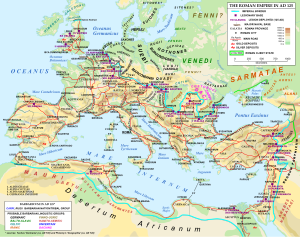
The Roman empire in 125 AD, under the rule of Hadrian.

Castel Sant’Angelo
, the ancient Hadrian
Mausoleum
.

This famous statue of Hadrian in Greek dress was revealed in 2008 to
have been forged in the
Victorian era
by cobbling together a head of Hadrian and an
unknown body. For years the statue had been used by historians as
proof of Hadrian’s love of Hellenic culture.
Hadrian quickly secured the support of the legions — one potential opponent,
Lusius Quietus
, was instantly dismissed.
The Senate’s endorsement followed when possibly falsified papers of adoption
from Trajan were presented (although he had been the ward of
Trajan
). The
rumor of a falsified document of adoption carried little weight — Hadrian’s
legitimacy arose from the endorsement of the Senate and the Syrian armies.
Hadrian did not at first go to Rome — he was busy sorting out the East and
suppressing the Jewish revolt that had broken out under Trajan, then moving on
to sort out the Danube
frontier. Instead, Attianus, Hadrian’s former guardian, was put in
charge in Rome. There he “discovered” a plot involving four leading Senators
including Lusius Quietus and demanded of the Senate their deaths. There was no
question of a trial — they were hunted down and killed out of hand. Because
Hadrian was not in Rome at the time, he was able to claim that Attianus had
acted on his own initiative. According to Elizabeth Speller the real reason for
their deaths was that they were Trajan’s men.
Hadrian
and the military
Despite his own great stature as a military administrator, Hadrian’s reign
was marked by a general lack of major military conflicts, apart from the Second
Roman-Jewish War. He surrendered Trajan’s conquests in
Mesopotamia
, considering them to be indefensible. There was almost a war
with Parthia
around 121, but the threat was averted when Hadrian succeeded in negotiating a
peace.
The peace policy was strengthened by the erection of permanent fortifications
along the empire’s borders (limites,
sl.
limes). The most famous of these is the massive
Hadrian’s Wall
in
Great
Britain
, and the
Danube
and
Rhine
borders
were strengthened with a series of mostly wooden
fortifications
, forts,
outposts
and
watchtowers
, the latter specifically improving communications and local area
security. To maintain morale and keep the troops from getting restive, Hadrian
established intensive drill routines, and personally inspected the armies.
Although his coins showed military images almost as often as peaceful ones,
Hadrian’s policy was peace through strength, even threat.
Cultural
pursuits and patronage
Hadrian has been described, by Ronald Syme among others, as the most
versatile of all the Roman Emperors. He also liked to display a knowledge of all
intellectual and artistic fields. Above all, Hadrian patronized the arts:
Hadrian’s Villa
at Tibur (Tivoli)
was the greatest Roman example of an
Alexandrian
garden, recreating a sacred landscape, lost in large part to the despoliation of
the ruins by the
Cardinal d’Este
who had much of the marble removed to build
Villa
d’Este
. In Rome
,
the Pantheon
, originally built by
Agrippa
but destroyed by fire in 80, was rebuilt under Hadrian in the domed
form it retains to this day. It is among the best preserved of Rome’s ancient
buildings and was highly influential to many of the great architects of the
Italian Renaissance
and
Baroque
periods.
From well before his reign, Hadrian displayed a keen interest in
architecture, but it seems that his eagerness was not always well received. For
example,
Apollodorus of Damascus
, famed architect of the
Forum of Trajan
, dismissed his designs. When
Trajan
,
predecessor to Hadrian, consulted Apollodorus about an architectural problem,
Hadrian interrupted to give advice, to which Apollodorus replied, “Go away and
draw your pumpkins. You know nothing about these problems.” “Pumpkins” refers to
Hadrian’s drawings of domes like the Serapeum in his Villa. It is rumored that
once Hadrian succeeded Trajan to become emperor, he had Apollodorus exiled and
later put to death. It is very possible that this later story was a later
attempt to defame his character, as Hadrian, though popular among a great many
across the empire, was not universally admired, either in his lifetime or
afterward.
Hadrian wrote poetry in both Latin and Greek; one of the few surviving
examples is a Latin poem he reportedly composed on his deathbed (see
below
). He
also wrote an autobiography – not, apparently, a work of great length or
revelation, but designed to scotch various rumours or explain his various
actions. The work is lost but was apparently used by the writer — whether
Marius Maximus
or someone else – on whom the Historia Augusta
principally relied for its vita of Hadrian: at least, a number of
statements in the vita have been identified (by
Ronald
Syme
and others) as probably ultimately stemming from the autobiography.
Hadrian was a passionate hunter, already from the time of his youth according
to one source.
In northwest Asia, he founded and dedicated a city to commemorate a she-bear he
killed.
It is documented that in Egypt he and his beloved
Antinous
killed a lion.
In Rome, eight reliefs featuring Hadrian in different stages of hunting on a
building that began as a monument celebrating a kill.
Another of Hadrian’s contributions to “popular” culture was the beard, which
symbolised his philhellenism. Except for
Nero (also a great
lover of Greek culture), all Roman emperors before Hadrian were clean shaven.
Most of the emperors after Hadrian would be portrayed with beards. Their beards,
however, were not worn out of an appreciation for Greek culture but because the
beard had, thanks to Hadrian, become fashionable. Hadrian had a face covered in
warts and scars, and this may have partially motivated Hadrian’s beard growth.
Hadrian was a
humanist
and deeply
Hellenophile
in all his tastes. He favoured the doctrines of the
philosophers Epictetus
, Heliodorus and
Favorinus
,
but was generally considered an
Epicurean
, as were some of his friends such as
Caius Bruttius Praesens
. At home he attended to social needs. Hadrian
mitigated but did not abolish slavery, had the legal code humanized and forbade
torture. He built libraries,
aqueducts
, baths and theaters. Hadrian is considered by many historians to
have been wise and just: Schiller called him “the Empire’s first servant”, and
British historian
Edward Gibbon
admired his “vast and active genius”, as well as his “equity
and moderation”. In 1776, he stated that Hadrian’s epoch was part of the
“happiest era of human history”.
While visiting Greece in 126, Hadrian attempted to create a kind of
provincial parliament
to bind all the semi-autonomous former city states across all
Greece and Ionia
(in
Asia Minor
). This parliament, known as the
Panhellenion
, failed despite spirited efforts to instill cooperation among
the Hellenes.
Hadrian had a close relationship, widely reported to have been romantic, with
a Greek youth, Antinous
, whom he met in
Bithynia
in
124 when the boy was thirteen or fourteen. While touring
Egypt
in 130, Antinous mysteriously drowned in the
Nile. Deeply
saddened, Hadrian founded the Egyptian city of
Antinopolis
, and had Antinous deified – an unprecedented honour for one not
of the ruling family.
Hadrian died at his villa in
Baiae
. He was
buried in a mausoleum
on the western bank of the
Tiber
, in
Rome, a building
later transformed into a papal fortress,
Castel Sant’Angelo
. The dimensions of his mausoleum, in its original form,
were deliberately designed to be slightly larger than the earlier
Mausoleum of Augustus
.
According to Cassius Dio a gigantic equestrian statue was erected to Hadrian
after his death. “It was so large that the bulkiest man could walk through the
eye of each horse, yet because of the extreme height of the foundation persons
passing along on the ground below believe that the horses themselves as well as
Hadrian are very small.”
Hadrian’s
travels
Purpose
The Stoic-Epicurean Emperor traveled broadly, inspecting and correcting the
legions in the field. Even prior to becoming emperor, he had traveled abroad
with the Roman military, giving him much experience in the matter. More than
half his reign was spent outside of Italy. Other emperors often left Rome to
simply go to war, returning soon after conflicts concluded. A previous emperor,
Nero, once traveled
through Greece and was condemned for his self indulgence. Hadrian, by contrast,
traveled as a fundamental part of his governing, and made this clear to the
Roman senate and the people. He was able to do this because at Rome he possessed
a loyal supporter within the upper echelons of Roman society, a military veteran
by the name of
Marcius Turbo
. Also, there are hints within certain sources that he also
employed a
secret police
force, the
frumentarii
, to exert control and influence in case anything should go wrong
while he journeyed abroad.
Hadrian’s visits were marked by handouts which often contained instructions
for the construction of new public buildings. Hadrian was willful of
strengthening the Empire from within through improved infrastructure, as opposed
to conquering or annexing perceived enemies. This was often the purpose of his
journeys; commissioning new structures, projects and settlements. His almost
evangelical belief in Greek culture strengthened his views: like many emperors
before him, Hadrian’s will was almost always obeyed. His traveling court was
large, including administrators and likely
architects
and
builders
. The burden on the areas he passed through were sometimes great.
While his arrival usually brought some benefits it is possible that those who
had to carry the burden were of different class to those who reaped the
benefits. For example, huge amounts of provisions were requisitioned during his
visit to Egypt
,
this suggests that the burden on the mainly
subsistence farmers
must have been intolerable, causing some measure of
starvation
and hardship.
At the same time, as in later times all the way through the European
Renaissance, kings were welcomed into their cities or lands, and the financial
burden was completely on them, and only indirectly on the poorer class.
Hadrian’s first tour came in 121 and was initially aimed at covering his back
to allow himself the freedom to concern himself with his general cultural aims.
He traveled north, towards
Germania
and inspected the Rhine-Danube frontier, allocating funds to improve the
defenses. However it was a voyage to the Empire’s very frontiers that
represented his perhaps most significant visit; upon hearing of a recent revolt,
he journeyed to Britannia.
Britannia
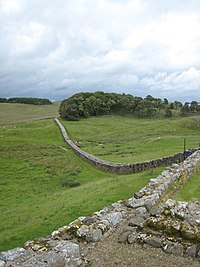
Hadrian’s Wall
(Vallum Hadriani), a fortification in Northern
England (viewed from
Vercovicium
)

Hadrian’s Gate
, in Antalya, southern Turkey was built to honour
Hadrian who visited the city in 130 CE.
Prior to Hadrian’s arrival on Great Britain there had been a major rebellion
in
Britannia
, spanning roughly two years (119–121).
It was here where in 122 he initiated the building of
Hadrian’s Wall
(the exact Latin name of which is unknown). The purpose of
the wall is academically debated. In 1893,
Haverfield
stated categorically that the Wall was a means of military
defence. This prevailing, early 20th century view was challenged by
Collingwood
[disambiguation
needed] in 1922. Since then, other points of view have been put
forwards; the wall has been seen as a marker to the limits of Romanitas,
as a monument to Hadrian to gain glory in lieu of military campaigns, as work to
keep the Army busy and prevent mutiny and waste through boredom, or to safeguard
the frontier province of Britannia, by preventing future small scale invasions
and unwanted immigration from the northern country of
Caledonia
(now modern day Scotland
). Caledonia was inhabited by tribes known to the Romans as
Caledonians
. Hadrian realized that the Caledonians would refuse to
cohabitate with the Romans. He also was aware that although Caledonia was
valuable, the harsh terrain and highlands made its conquest costly and
unprofitable for the Empire at large. Thus, he decided instead on building a
wall. Unlike the
Germanic limes
, built of wood palisades, the lack of suitable wood in the
area required a stone construction;
nevertheless, the Western third of the wall, from modern-day Carlisle to the
River Irthing, was built of turf because of the lack of suitable building stone.
This problem also led to the narrowing of the width of the wall, from the
original 12 feet to 7, saving masonry.
Hadrian is perhaps most famous for the construction of this wall whose ruins
still span many miles and to date bear his name. In many ways it represents
Hadrian’s will to improve and develop within the
Empire
,
rather than waging wars and conquering.
Under him, a shrine was erected in
York to Britain as
a Goddess, and coins were struck which introduced a female figure as the
personification of Britain, labeled
BRITANNIA
.
By the end of 122 he had concluded his visit to Britannia, and from there headed
south by sea to
Mauretania
.
Parthia
and Anatolia
In 123, he arrived in
Mauretania
where he personally led a campaign against local rebels.
However this visit was to be short, as reports came through that the Eastern
nation of Parthia
was again preparing for war, as a result Hadrian quickly headed eastwards. On
his journey east it is known that at some point he visited
Cyrene
during which he personally made available funds for the training of
the young men of well bred families for the Roman military. This might well have
been a stop off during his journey East. Cyrene had already benefited from his
generosity when he in 119 had provided funds for the rebuilding of public
buildings destroyed in the recent Jewish revolt.
When Hadrian arrived on the
Euphrates
,
he characteristically solved the problem through a negotiated settlement with
the Parthian king
Osroes I
. He then proceeded to check the Roman defenses before setting off
West along the coast of the
Black Sea
.
He probably spent the winter in
Nicomedia
,
the main city of
Bithynia
.
As Nicomedia had been hit by an earthquake only shortly prior to his stay,
Hadrian was generous in providing funds for rebuilding. Thanks to his generosity
he was acclaimed as the chief restorer of the province as a whole. It is more
than possible that Hadrian visited
Claudiopolis
and there espied the beautiful
Antinous
, a
young boy who was destined to become the emperor’s
beloved
. Sources say nothing about when Hadrian met Antinous, however, there
are depictions of Antinous that shows him as a young man of 20 or so. As this
was shortly before Antinous’s drowning in 130 Antinous would more likely have
been a youth of 13 or 14.
It is possible that Antinous may have been sent to Rome to be trained as
page
to serve the emperor and only gradually did he rise to the status of
imperial favorite.
After meeting Antinous, Hadrian traveled through
Anatolia
.
The route he took is uncertain. Various incidents are described such as his
founding of a city within Mysia, Hadrianutherae, after a successful boar hunt.
(The building of the city was probably more than a mere whim — lowly populated
wooded areas such as the location of the new city were already ripe for
development). Some historians dispute whether Hadrian did in fact commission the
city’s construction at all. At about this time, plans to build a temple in Asia
minor were written up. The new temple would be dedicated to Trajan and Hadrian
and built with dazzling white marble.
Greece
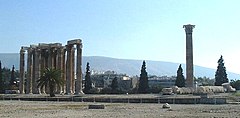
Temple of Zeus in Athens.
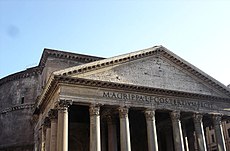
The
Pantheonn
was rebuilt by Hadrian.
The climax of this tour was the destination that the hellenophile Hadrian
must all along have had in mind, Greece. He arrived in the autumn of 124 in time
to participate in the
Eleusinian Mysteries
. By tradition at one stage in the ceremony the
initiates were supposed to carry arms but this was waived to avoid any risk to
the emperor among them. At the Athenians’ request he conducted a revision of
their constitution — among other things a new
phyle
(tribe) was
added bearing his name.
During the winter he toured the
Peloponnese
. His exact route is uncertain, however
Pausanias
reports of tell-tale signs, such as temples built by Hadrian and
the statue of the emperor built by the grateful citizens of
Epidaurus
in thanks to their “restorer”. He was especially generous to
Mantinea
which supports the theory that Antinous was in fact already
Hadrian’s lover because of the strong link between Mantinea and Antinous’s home
in Bithynia
.
By March 125, Hadrian had reached
Athens
presiding over the festival of
Dionysia
.
The building program that Hadrian initiated was substantial. Various rulers had
done work on building the
Temple of Olympian Zeus
— it was Hadrian who ensured that the job would be
finished. He also initiated the construction of several public buildings on his
own whim and even organized the building of an aqueduct.
Return
to Italy
On his return to Italy, Hadrian made a detour to
Sicily
. Coins
celebrate him as the restorer of the island though there is no record of what he
did to earn this accolade.
Back in Rome he was able to see for himself the completed work of rebuilding
the Pantheon
. Also completed by then was Hadrian’s villa nearby at
Tibur
a pleasant retreat by the
Sabine Hills
for whenever Rome became too much for him. At the beginning of
March 127 Hadrian set off for a tour of Italy. Once again, historians are able
to reconstruct his route by evidence of his hand-outs rather than the historical
records. For instance, in that year he restored the Picentine earth goddess
Cupra
in the town
of
Cupra Maritima
. At some unspecified time he improved the drainage of the
Fucine lake
. Less welcome than such largesse was his decision to divide
Italy into 4 regions under imperial legates with consular rank. Being
effectively reduced to the status of mere provinces did not go down well and
this innovation did not long outlive Hadrian.
Hadrian fell ill around this time, though the nature of his sickness is not
known. Whatever the illness was, it did not stop him from setting off in the
spring of 128 to visit
Africa
. His
arrival began with the good omen of rain ending a
drought
.
Along with his usual role as benefactor and restorer he found time to inspect
the troops and his speech to the troops survives to this day.
Hadrian returned to Italy in the summer of 128 but his stay was brief before
setting off on another tour that would last three years.
Greece,
Asia and Egypt
In September 128 Hadrian again attended the Eleusinian mysteries. This time
his visit to Greece seems to have concentrated on Athens and Sparta — the two
ancient rivals for dominance of Greece. Hadrian had played with the idea of
focusing his Greek revival round
Amphictyonic League
based in Delphi but he by now had decided on something
far grander. His new Panhellenion was going to be a council that would bring
together Greek cities wherever they might be found. The meeting place was to be
the new temple to Zeus in Athens. Having set in motion the preparations —
deciding whose claim to be a Greek city was genuine would in itself take time —
Hadrian set off for
Ephesus
.
In October 130, while Hadrian and his entourage were sailing on the
Nile,
Antinous
drowned, for unknown reasons, though accident, suicide, murder or religious
sacrifice have all been postulated. The emperor was grief stricken. He ordered
Antinous
deified, and cities were named after the boy, medals struck with his effigy, and
statues erected to him in all parts of the empire. Temples were built for his
worship in Bithynia, Mantineia in Arcadia, and Athens, festivals celebrated in
his honour and oracles delivered in his name. The city of
Antinopolis
or Antinoe was founded on the ruins of
Besa
where he died (Cassius Dio, LIX.11; Historia Augusta, Hadrian).
Greece,
Judaea, Illyricum
Hadrian’s movements subsequent to the founding of
Antinopolis
on October 30, 130 are obscure. Whether or not he returned to
Rome, he spent the winter of 131–32 in Athens and probably remained in Greece or
further East because of the Jewish rebellion which broke out in Judaea in 132
(see below). Inscriptions make it clear that he took the field in person against
the rebels with his army in 133; he then returned to Rome, probably in that year
and almost certainly (judging again from inscriptions) via
Illyricum
.
Second
Roman-Jewish War
See also:
Bar Kokhba revolt
In 130, Hadrian visited the ruins of
Jerusalem
,
in Judaea
, left
after the
First Roman-Jewish War
of 66–73. He rebuilt the city, renaming it
Aelia Capitolina
after himself and
Jupiter Capitolinus
, the chief Roman deity. A new temple dedicated to the
worship of
Jupiter
was built on the ruins of the old Jewish
Second Temple
, which had been destroyed in 70.
In addition, Hadrian abolished
circumcision
, which was considered by Romans and Greeks as a form of bodily
mutilation
and hence “barbaric”.
These anti-Jewish policies of Hadrian triggered in Judaea a massive Jewish
uprising, led by
Simon bar Kokhba
and
Akiba ben Joseph
. Following the outbreak of the revolt, Hadrian called his
general
Sextus Julius Severus
from
Britain
, and troops were brought from as far as the
Danube
. Roman
losses were very heavy, and it is believed that an entire legion, the
XXII Deiotariana
was destroyed.[45]
Indeed, Roman losses were so heavy that Hadrian’s report to the
Roman
Senate
omitted the customary salutation “I and the legions are well”.
However, Hadrian’s army eventually put down the rebellion in 135, after three
years of fighting. According to
Cassius
Dio
, during the war 580,000 Jews were killed, 50 fortified towns and 985
villages razed. The final battle took place in
Beitar
, a fortified city 10 km. southwest of Jerusalem. The city only fell
after a lengthy siege, and Hadrian only allowed the Jews to bury their dead
after a period of six days. According to the Babylonian
Talmud
,
after the war Hadrian continued the persecution of Jews. He attempted to root
out Judaism
,
which he saw as the cause of continuous rebellions, prohibited the
Torah
law, the
Hebrew calendar
and executed Judaic scholars (see
Ten
Martyrs
). The sacred scroll was ceremonially burned on the
Temple
Mount
. In an attempt to erase the memory of Judaea, he renamed the province
Syria Palaestina
(after the
Philistines
), and Jews were forbidden from entering its rededicated capital.
When Jewish sources mention Hadrian it is always with the epitaph “may his bones
be crushed” (שחיק עצמות or שחיק טמיא, the Aramaic equivalent),
an expression never used even with respect to
Vespasian
or Titus
who
destroyed the
Second Temple
.
Final
years
Succession
Hadrian spent the final years of his life at Rome. In 134, he took an
Imperial salutation
or the end of the Second Jewish War (which was not actually
concluded until the following year). In 136, he dedicated a new
Temple of Venus and Roma
on the former site of
Nero‘s
Golden House
.
About this time, suffering from poor health, he turned to the problem of the
succession. In 136 he adopted one of the ordinary
consuls
of that year, Lucius Ceionius Commodus, who took the name
Lucius Aelius Caesar
. He was both the stepson and son-in-law of Gaius
Avidius Nigrinus, one of the “four consulars” executed in 118, but was himself
in delicate health. Granted tribunician power and the governorship of
Pannonia
,
Aelius Caesar held a further consulship in 137, but died on January 1, 138.
Following the death of Aelius Caesar, Hadrian next adopted Titus Aurelius
Fulvus Boionius Arrius Antoninus (the future emperor
Antoninus Pius
), who had served as one of the four imperial legates of Italy
(a post created by Hadrian) and as
proconsul
of
Asia
. On 25 February 138 Antoninus received tribunician power and
imperium
.
Moreover, to ensure the future of the dynasty, Hadrian required Antoninus to
adopt both Lucius Ceionius Commodus (son of the deceased Aelius Caesar) and
Marcus Annius Verus (who was the grandson of an influential senator
of the same name
who had been Hadrian’s close friend; Annius was already
betrothed to Aelius Caesar’s daughter Ceionia Fabia). Hadrian’s precise
intentions in this arrangement are debatable. Though the consensus is that he
wanted Annius Verus (who would later become the Emperor
Marcus Aurelius
) to succeed Antoninus, it has also been argued that he
actually intended Ceionius Commodus, the son of his own adopted son, to succeed,
but was constrained to show favour simultaneously to Annius Verus because of his
strong connections to the Hispano-Narbonensian nexus of senatorial families of
which Hadrian himself was a part. It may well not have been Hadrian, but rather
Antoninus Pius — who was Annius Verus’s uncle – who advanced the latter to the
principal position. The fact that Annius would divorce Ceionia Fabia and
re-marry to Antoninus’ daughter Annia Faustina points in the same direction.
When he eventually became Emperor, Marcus Aurelius would co-opt Ceionius
Commodus as his co-Emperor (under the name of
Lucius
Verus
) on his own initiative.
The ancient sources present Hadrian’s last few years as marked by conflict
and unhappiness. The adoption of Aelius Caesar proved unpopular, not least with
Hadrian’s brother-in-law
Lucius Julius Ursus Servianus
and Servianus’ grandson Gnaeus Pedanius Fuscus
Salinator. Servianus, though now far too old, had stood in line of succession at
the beginning of the reign; Fuscus is said to have had designs on the imperial
power for himself, and in 137 he may have attempted a
coup
in which his grandfather was implicated. Whatever the truth, Hadrian ordered
that both be put to death.
Servianus is reported to have prayed before his execution that Hadrian would
“long for death but be unable to die”.
The prayer was fulfilled; as Hadrian suffered from his final, protracted
illness, he had to be prevented from
suicide
on
several occasions.
Death
Hadrian died in 138 on the tenth day of July, in his
villa
at Baiae
at age
62. The cause of death is believed to have been heart failure.
Dio Cassius
and the
Historia Augusta
record details of his failing health, and a study published
in 1980 drew attention to classical sculptures of Hadrian that show he had
diagonal earlobe creases – a characteristic associated with
coronary heart disease
.
Hadrian was buried first at
Puteoli
, near Baiae, on an estate which had once belonged to
Cicero
. Soon
after, his remains were transferred to Rome and buried in the Gardens of Domitia,
close by the almost-complete mausoleum. Upon the completion of the
Tomb of Hadrian
in Rome
in 139 by his successor
Antoninus Pius
, his body was cremated, and his ashes were placed there
together with those of his wife
Vibia
Sabina
and his first adopted son,
Lucius Aelius
, who also died in 138. Antoninus also had him deified in 139
and given a
temple
on the
Campus Martius
.
Poem
by Hadriann
According to the
Historia Augusta
Hadrian composed shortly before his death the following
poem:
-
Animula, vagula, blandula
-
Hospes comesque corporis
-
Quae nunc abibis in loca
-
Pallidula, rigida, nudula,
-
Nec, ut soles, dabis iocos…
-
-
-
P. Aelius Hadrianus Imp.
-
Little soul, roamer and charmerr
-
Body’s guest and companion
-
Into what places will you now depart
-
Pale, stiff, and nude
-
An end to all your jokes…
The sestertius, or sesterce, (pl. sestertii) was an
ancient Roman
coin
. During the
Roman Republic
it was a small,
silver
coin issued only on rare occasions.
During the
Roman Empire
it was a large
brass
coin.

Helmed Roma head right, IIS behind
Dioscuri
riding right, ROMA in linear frame
below. RSC4, C44/7, BMC13.
The name sestertius (originally semis-tertius) means “2 ½”,
the coin’s original value in
asses
, and is a combination of semis
“half” and tertius “third”, that is, “the third half” (0 ½ being
the first half and 1 ½ the second half) or “half the third” (two
units plus half the third unit, or halfway between the second
unit and the third). Parallel constructions exist in
Danish
with halvanden (1 ½),
halvtredje (2 ½) and halvfjerde (3 ½). The form sesterce,
derived from
French
, was once used in preference to the
Latin form, but is now considered old-fashioned.
It is abbreviated as (originally IIS).

Example of a detailed portrait of
Hadrian
117 to 138
History
The sestertius was introduced c. 211 BC as a small
silver
coin valued at one-quarter of a
denarius
(and thus one hundredth of an
aureus
). A silver denarius was supposed to
weigh about 4.5 grams, valued at ten grams, with the silver sestertius
valued at two and one-half grams. In practice, the coins were usually
underweight.
When the denarius was retariffed to sixteen asses (due to the gradual
reduction in the size of bronze denominations), the sestertius was
accordingly revalued to four asses, still equal to one quarter of a
denarius. It was produced sporadically, far less often than the denarius,
through 44 BC.

Hostilian
under
Trajan Decius
250 AD
In or about 23 BC, with the coinage reform of
Augustus
, the denomination of sestertius
was introduced as the large brass denomination. Augustus tariffed the value
of the sestertius as 1/100
Aureus
. The sestertius was produced as the
largest brass
denomination until the late 3rd
century AD. Most were struck in the mint of
Rome
but from AD 64 during the reign of
Nero
(AD 54–68) and
Vespasian
(AD 69–79), the mint of
Lyon
(Lugdunum), supplemented
production. Lyon sestertii can be recognised by a small globe, or legend
stop), beneath the bust.[citation
needed]
The brass sestertius typically weighs in the region of 25 to 28 grammes,
is around 32–34 mm in diameter and about 4 mm thick. The distinction between
bronze
and brass was important to the
Romans. Their name for
brass
was
orichalcum
, a word sometimes also spelled
aurichalcum (echoing the word for a gold coin, aureus), meaning
‘gold-copper’, because of its shiny, gold-like appearance when the coins
were newly struck (see, for example
Pliny the Elder
in his Natural History
Book 34.4).
Orichalcum
was considered, by weight, to be
worth about double that of bronze. This is why the half-sestertius, the
dupondius
, was around the same size and
weight as the bronze as, but was worth two asses.
Sestertii continued to be struck until the late 3rd century, although
there was a marked deterioration in the quality of the metal used and the
striking even though portraiture remained strong. Later emperors
increasingly relied on melting down older sestertii, a process which led to
the zinc component being gradually lost as it burned off in the high
temperatures needed to melt copper (Zinc
melts at 419 °C,
Copper
at 1085 °C). The shortfall was made
up with bronze and even lead. Later sestertii tend to be darker in
appearance as a result and are made from more crudely prepared blanks (see
the Hostilian
coin on this page).
The gradual impact of
inflation
caused by
debasement
of the silver currency meant
that the purchasing power of the sestertius and smaller denominations like
the dupondius and as was steadily reduced. In the 1st century AD, everyday
small change was dominated by the dupondius and as, but in the 2nd century,
as inflation bit, the sestertius became the dominant small change. In the
3rd century silver coinage contained less and less silver, and more and more
copper or bronze. By the 260s and 270s the main unit was the
double-denarius, the
antoninianus
, but by then these small coins
were almost all bronze. Although these coins were theoretically worth eight
sestertii, the average sestertius was worth far more in plain terms of the
metal they contained.
Some of the last sestertii were struck by
Aurelian
(270–275 AD). During the end of
its issue, when sestertii were reduced in size and quality, the
double sestertius
was issued first by
Trajan Decius
(249–251 AD) and later in
large quantity by the ruler of a breakaway regime in the West called
Postumus
(259–268 AD), who often used worn
old sestertii to
overstrike
his image and legends on. The
double sestertius was distinguished from the sestertius by the
radiate crown
worn by the emperor, a device
used to distinguish the dupondius from the as and the antoninianus from the
denarius.
Eventually, the inevitable happened. Many sestertii were withdrawn by the
state and by forgers, to melt down to make the debased antoninianus, which
made inflation worse. In the coinage reforms of the 4th century, the
sestertius played no part and passed into history.
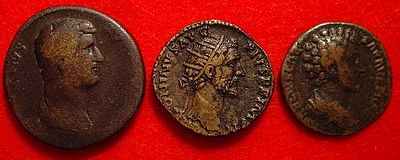
Sestertius of
Hadrian
, dupondius of
Antoninus Pius
, and as of
Marcus Aurelius
As a unit of account
The sestertius was also used as a standard unit of account, represented
on inscriptions with the monogram HS. Large values were recorded in terms of
sestertium milia, thousands of sestertii, with the milia often
omitted and implied. The hyper-wealthy general and politician of the late
Roman Republic,
Crassus
(who fought in the war to defeat
Spartacus
), was said by Pliny the Elder to
have had ‘estates worth 200 million sesterces’.
A loaf of bread cost roughly half a sestertius, and a
sextarius
(~0.5 liter) of
wine
anywhere from less than half to more
than 1 sestertius. One
modius
(6.67 kg) of
wheat
in 79 AD
Pompeii
cost 7 sestertii, of
rye
3 sestertii, a bucket 2 sestertii, a
tunic 15 sestertii, a donkey 500 sestertii.
Records from
Pompeii
show a
slave
being sold at auction for 6,252
sestertii. A writing tablet from
Londinium
(Roman
London
), dated to c. 75–125 AD, records the
sale of a Gallic
slave girl called Fortunata for 600
denarii, equal to 2,400 sestertii, to a man called Vegetus. It is difficult
to make any comparisons with modern coinage or prices, but for most of the
1st century AD the ordinary
legionary
was paid 900 sestertii per annum,
rising to 1,200 under
Domitian
(81-96 AD), the equivalent of 3.3
sestertii per day. Half of this was deducted for living costs, leaving the
soldier (if he was lucky enough actually to get paid) with about 1.65
sestertii per day.
Perhaps a more useful comparison is a modern salary: in 2010 a private
soldier in the US Army (grade E-2) earned about $20,000 a year.
Numismatic value

A sestertius of
Nero
, struck at
Rome
in 64 AD. The reverse
depicts the emperor on horseback with a companion. The legend
reads DECVRSIO, ‘a military exercise’. Diameter 35mm
Sestertii are highly valued by
numismatists
, since their large size gave
caelatores (engravers) a large area in which to produce detailed
portraits and reverse types. The most celebrated are those produced for
Nero
(54-68 AD) between the years 64 and 68
AD, created by some of the most accomplished coin engravers in history. The
brutally realistic portraits of this emperor, and the elegant reverse
designs, greatly impressed and influenced the artists of the
Renaissance
. The series issued by
Hadrian
(117-138 AD), recording his travels
around the Roman Empire, brilliantly depicts the Empire at its height, and
included the first representation on a coin of the figure of
Britannia
; it was revived by
Charles II
, and was a feature of
United Kingdom
coinage until the
2008 redesign
.
Very high quality examples can sell for over a million
dollars
at auction as of 2008, but the
coins were produced in such colossal abundance that millions survive.
|





















